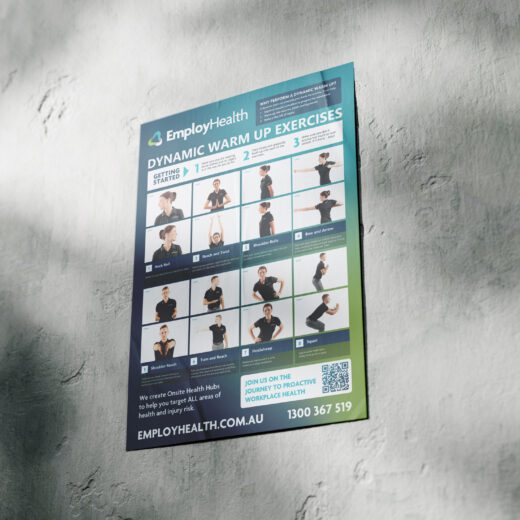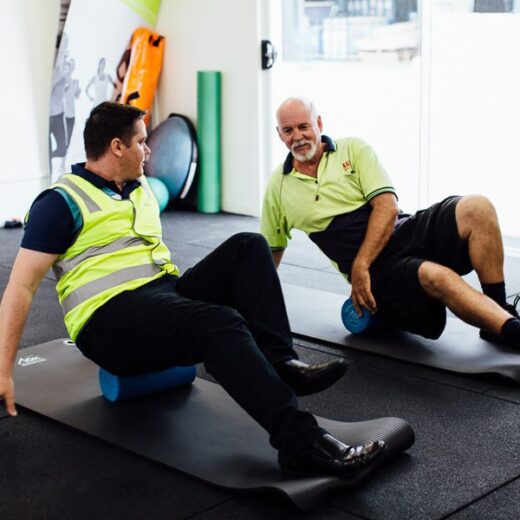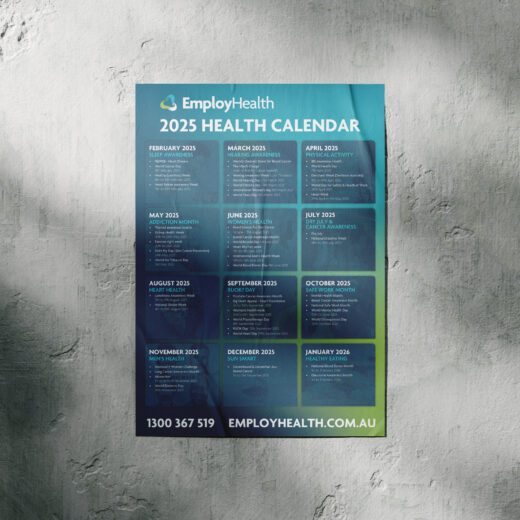
Download a Dynamic Warm Up Poster for your Workers
This easy-to-follow poster is specially crafted to help workers prepare their bodies for the physical demands of manual labour, significantly reducing the risk of...
Read moreAt Employ Health, we are committed to providing your workforce with the unique opportunity to elevate their capacity so that they can meet (and even exceed) their job demands, enhancing both their safety and performance. So, what is strength and conditioning? Following a thorough assessment of both the individual and their job tasks, we design and implement individualised programs focused on maximising physical potential and reducing the risk of injury in the workplace.

A strength and conditioning program implemented in the workplace consists of individualised, progressive exercises designed to support improved balance, functional strength, endurance, flexibility and fitness and to enhance overall movement quality. Typical exercises prescribed include those with maximise core endurance, upper limb strength and endurance and lower limb strength.
Physical strength and conditioning is one of the key principles of injury prevention and management. Well structured and individually prescribed conditioning programs decrease the risk of injury, the severity of injury and can help prevent re-injury. Just like you would expect with management of an elite sporting athlete, maximising the chance of safe work performance requires a worker to have adequate muscular strength and balance, power, coordination, flexibility and endurance in order to maximise their performance and reduce their risk of injury.
An injury will heal fastest by gradually introducing loads to the injured tissues. Part of this may be a graduated strength and conditioning program guided by your Employ Health physiotherapist so that the body will adapt to loads as the worker gradually returns to their normal duties. This gives the worker every chance to bounce back even fitter and stronger than before.
The body’s tissues, joints and ligaments have a limited capacity to handle stress and work. Once that limit is reached, they are prone to fatigue which means everything is working against you. An individually prescribed strength and conditioning program is designed to increase the limits of an individual’s load bearing and stress capacity, increasing physical performance and their overall capacity to meet the demands of their work roles, safely and efficiently. Strengthening helps improve a worker’s range of motion and mobility, increasing efficiency and performance as well as reducing fatigue and change of injury.
Research proves that workplace strength and conditioning programs improve worker performance and productivity. Not only does this improve the overall health outcomes for the individual but also provides great benefits to the organisation.
With musculoskeletal injuries accounting for the largest proportion of workers compensation claims, it becomes increasingly important for an organisation to truly embody core health values not only as a way of reducing workplace injuries but maximising worker potential.
There is strong evidence that exercise improves concentration, stress management and levels of engagement which would naturally translate to greater levels of productivity and decreased sickness and absenteeism.
It has been shown healthier employees spend fewer days away from work due to illness, saving organisations thousands, even millions, of dollars on down time and temporary employment. Additionally, because good health typically carries over into better family choices, your employees could possibly miss less work caring for sick family members.
One of the greatest indicators of injury is an inherent mismatch of worker capacity to the demands of their role. Employ Health utilises data gleaned from our Job Hub to tailor strength & conditioning programs to the specific demands of a worker’s task, eliminating capacity mismatches and reducing your site risk profile.
Employ Health has been partnering with businesses across Australia for the last 10 years to highlight the importance of worker capacity as a key indicator of injury risk. Through our Prehab Strength & Conditioning programs, we have been able to map out site capacity risk profiles and display this data to our partners in our Data Management Software.
Through our Prehab Strength & Conditioning programs, Employ Health has been able to use the guideline of an average of 8 weeks of training for workers to raise their capacity by at least one level (i.e. from ‘Light’ to ‘Medium’)
Having a capacity that meets or exceeds the demands of a job role is integral in injury prevention. It is no surprise that – in businesses we have capacity risk profiled – worker’s with a capacity mismatch often have active injuries or are struggling with chronic musculoskeletal conditions!
Our Prehab Strength & Conditioning programs are designed for both improving manual technique as well as muscle building, a process referred to as Hypertrophy. Using principles of progressive overload, we utilize a graded increase in various intensity methods to produce a biological environment for muscle growth.
Any exercise that creates mechanical damage to muscle proteins will act as a strength & conditioning exercise when carried out under the appropriate loading conditions. Some key exercises include:
With any physical movement of the body comes risk. Employ Health are experts in our field when it comes to elite exercise prescription and we strive to always create a safe strengthening environment. While post exercise soreness can occur (Often known as Delayed Onset Muscle Soreness, or DOMS) what does however contribute greater to site risk is the effects of weak and deconditioned workers. Workers in this category are more likely to suffer more severe strains & sprains and are less likely to recover.

This easy-to-follow poster is specially crafted to help workers prepare their bodies for the physical demands of manual labour, significantly reducing the risk of...
Read more
Securing Health In today’s digital age, the security of personal and health-related data is more crucial than ever, especially when selecting workplace healthcare providers. Employ...
Read more
World Health Day, observed every year on April 7th, is a global health awareness day under the sponsorship of the World Health Organization (WHO)....
Read more
April is Physical Activity Month on the Employ Health wellness calendar, focusing on the pivotal role of physical activity in maintaining health and enhancing...
Read more
Employ Health is committed to advancing workplace health standards through continuous technological improvements. Our latest update to the audiometry reporting system is designed to...
Read more
An Integrated Approach to Employee Wellness The health and well-being of employees is crucial to the success of any organisation. Companies face a critical decision...
Read more
Turning Down the Volume March is Hearing Awareness Month in Employ Health’s wellness calendar, a critical time to spotlight the importance of hearing health, particularly...
Read more
A Call to Action for Workplaces Every year on March 8th, the world celebrates International Women’s Day (IWD), a day dedicated to honouring the achievements...
Read more
Stay Informed, Stay Healthy Welcome to Employ Health’s exclusive resource for enhancing workplace wellness—our 2025 Health Calendar! Each month, we spotlight a crucial health topic...
Read more
The well-being of employees is a critical concern for many businesses. One crucial aspect often overlooked is the quality of sleep. February is Sleep...
Read more
Stepping into the new year, it’s the perfect time for businesses to prioritise the health and well-being of their teams. Employ Health’s 8 Week...
Read more
Workplace safety is a paramount concern for any business, and one of the critical areas often overlooked is the impact of drugs and alcohol....
Read moreCan’t find what you’re after?
View all articles